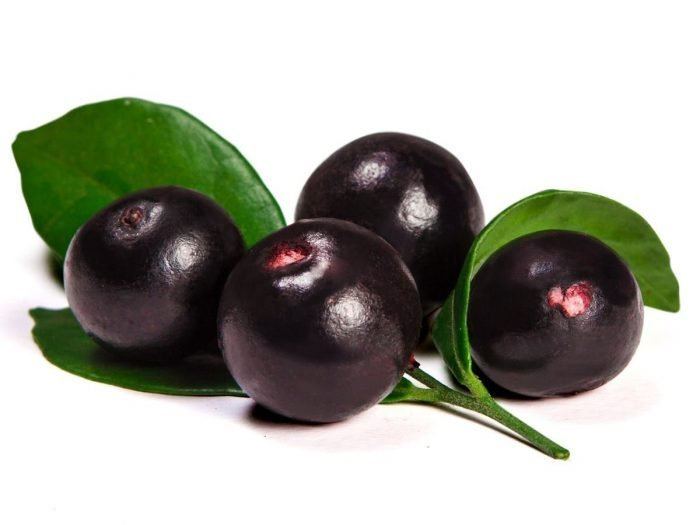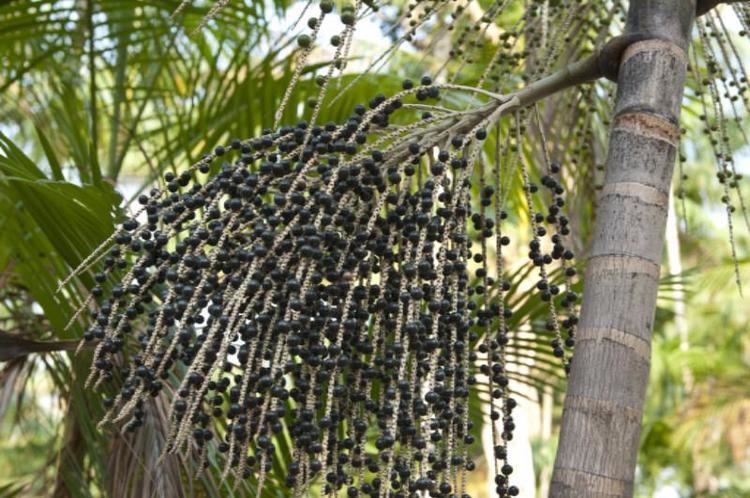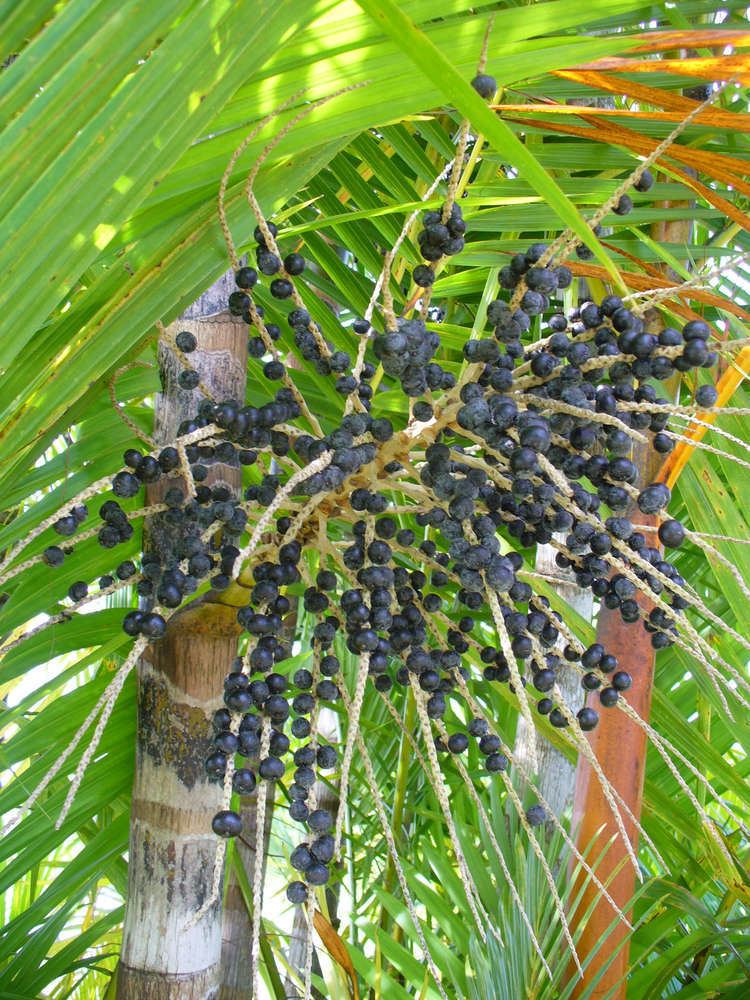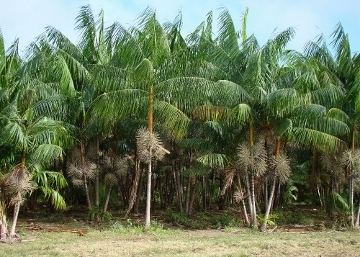Rank Species | Higher classification Euterpe | |
 | ||
Similar Guarana, Cupuaçu, Chia, Blueberry, Chokeberry | ||
The açaí palm ([aˌsaˈi], asaí; Euterpe oleracea) is a species of palm tree in the genus Euterpe cultivated for its fruit and hearts of palm. Its name comes from the Portuguese adaptation of the Tupian word ïwaca'i, '[fruit that] cries or expels water'. Global demand for the fruit has expanded rapidly in recent years, and açaí is now cultivated for that purpose primarily. Euterpe edulis (juçara) is a closely related species which is now the primary source of hearts of palm.
Contents
- Fruit
- Cultivars
- Other uses
- Nutritional content
- Food product
- Dietary supplement
- Polyphenols and antioxidant activity in vitro
- Juice blend studies
- Oil phytochemicals
- References

Euterpe oleracea is mostly native to Brazil and Trinidad and northern South America, mainly in swamps and floodplains. Açaí palms are tall, slender palms growing to more than 25 m (82 ft) tall, with pinnate leaves up to 3 m (9.8 ft) long.

Fruit

The fruit, commonly known as açaí berry, is a small, round, black-purple drupe about 25 mm (1 in) in circumference, similar in appearance to a grape, but smaller and with less pulp and produced in branched panicles of 500 to 900 fruits. The exocarp of the ripe fruits is a deep purple color, or green, depending on the kind of açaí and its maturity. The mesocarp is pulpy and thin, with a consistent thickness of 1 mm (0.04 in) or less. It surrounds the voluminous and hard endocarp, which contains a single large seed about 7–10 mm (0.3–0.4 in) in diameter. The seed makes up about 80% of the fruit. Two crops of fruit are produced each year and is harvested during the dry season between July and December.

In a study of three traditional Caboclo populations in the Brazilian Amazon, açaí palm was described as the most important plant species because the fruit makes up a major component of their diet, up to 42% of the total food intake by weight.

In 2005, an article published by Greenpeace International stated that “the tasty dark violet wine of açaí is the most important non-wood forest product in terms of money from the river delta of the Amazon.” A 2008 Los Angeles Times article noted that while açaí has been acclaimed by some sources as a renewable resource that can provide a sustainable livelihood for subsistence harvesters without damaging the Amazon Rainforest, conservationists worry that açaí could succumb to the destructive agribusiness model of clear-cut lands, sprawling plantations, and liberal application of pesticides and fertilizer. Although most açaí is grown conventionally, the US company Sambazon established USDA Organic certification for their açaí palm plantations in 2003 and has also implemented fair trade certification.
Cultivars
Few named cultivars exist, and varieties differ mostly in the nature of the fruit:
Other uses
Apart from the use of its fruit as food or beverage, the açaí palm has other commercial uses. Leaves may be made into hats, mats, baskets, brooms and roof thatch for homes, and trunk wood, resistant to pests, for building construction. Tree trunks may be processed to yield dietary minerals. The palm heart is widely exploited as a delicacy.
Comprising 80% of the fruit mass, açaí seeds may be ground for livestock food or as a component of organic soil for plants. Planted seeds are used for new palm tree stock, which, under the right growing conditions, can require months to form seedlings. The seeds are a source of polyunsaturated and saturated fatty acids.
Nutritional content
A powdered preparation of freeze-dried açaí fruit pulp and skin was reported to contain (per 100 g of dry powder) 533.9 calories, 52.2 g carbohydrates, 8.1 g protein, and 32.5 g total fat. The carbohydrate portion included 44.2 g of dietary fiber and low sugar value (pulp is not sweet). The powder was also shown to contain (per 100 g): negligible vitamin C, 260 mg calcium, 4.4 mg iron, and 1002 U vitamin A, as well as aspartic acid and glutamic acid; the amino acid content was 7.59% of total dry weight (versus 8.1% protein).
The fat content of açaí consists of oleic acid (56.2% of total fats), palmitic acid (24.1%), and linoleic acid (12.5%). Açaí also contains beta-sitosterol (78–91% of total sterols).
Food product
In the general consumer market, açaí is sold as frozen pulp, juice, or an ingredient in various products from beverages, including grain alcohol, smoothies, foods, cosmetics and supplements. In Brazil, it is commonly eaten as açaí na tigela.
Dietary supplement
In 2004, it became popular to consume açaí as a supplement. The proliferation of various açaí supplement companies often misused celebrity names like Oprah Winfrey and Rachael Ray to promote açaí weight loss pills online.
Marketers of these products made unfounded claims that açaí and its antioxidant qualities provide a variety of health benefits, none of which has scientific confirmation to date. False claims include reversal of diabetes and other chronic illnesses, as well as expanding size of the penis and increasing men's sexual virility. As of 2015, there are no scientifically controlled studies providing proof of any health benefits from consuming açaí. No açaí products have been evaluated by the FDA, and their efficacy is doubtful. Specifically, there is no scientific evidence that açaí consumption affects body weight, promotes weight loss or has any positive health effect.
According to the Washington, D.C. based Center for Science in the Public Interest (CSPI) thousands of consumers have had trouble stopping recurrent charges on their credit cards when they cancel free trials of açai-based products. Even some web sites purporting to warn about açai-related scams are themselves perpetrating scams.
In late 2008, lawyers for The Oprah Winfrey Show began investigating statements from supplement manufacturers who alleged that frequent Oprah guest Dr. Mehmet Oz had recommended their product or açai in general for weight loss.
Polyphenols and antioxidant activity in vitro
The oil compartments in açaí fruit contain polyphenols such as procyanidin oligomers and vanillic acid, syringic acid, p-hydroxybenzoic acid, protocatechuic acid, and ferulic acid, which were shown to degrade substantially during storage or exposure to heat. Although these compounds are under study for potential health effects, there remains no substantial evidence that açaí polyphenols have any effect in humans.
A comparative analysis from in vitro studies reported that açaí has intermediate polyphenol content and antioxidant potency among 11 varieties of frozen juice pulps, scoring lower than acerola, mango, strawberry, and grapes.
A powdered preparation of freeze-dried açaí fruit pulp and skin was shown to contain cyanidin 3-O-glucoside and cyanidin 3-O-rutinoside as major anthocyanins; (3.19 mg/g) however, anthocyanins accounted for only about 10% of the overall antioxidant capacity in vitro. The powdered preparation was also reported to contain twelve flavonoid-like compounds, including homoorientin, orientin, taxifolin deoxyhexose, isovitexin, scoparin, as well as proanthocyanidins (12.89 mg/g), and low levels of resveratrol (1.1 μg/g).
The anthocyanins of fruit likely have relevance to antioxidant capacity only in the plant's natural defensive mechanisms and in vitro. The Linus Pauling Institute and European Food Safety Authority state that dietary anthocyanins and other flavonoids have little or no direct antioxidant food value following digestion. Unlike controlled test tube conditions, the fate of anthocyanins in vivo shows they are poorly conserved (less than 5%), with most of what is absorbed existing as chemically modified metabolites destined for rapid excretion.
When the entire scientific literature to date and putative health claims of açaí are assessed, experts concluded in 2011 that the fruit is more a phenomenon of Internet marketing than of scientific substance.
Juice blend studies
Various studies have been conducted that analyze the antioxidant capacity of açaí juice blends to pure fruit juices or fruit pulp. Açaí juice blends contain an undisclosed percentage of açaí.
When three commercially available juice mixes containing unspecified percentages of açaí juice were compared for in vitro antioxidant capacity against red wine, tea, six types of pure fruit juice, and pomegranate juice, the average antioxidant capacity was ranked lower than that of pomegranate juice, Concord grape juice, blueberry juice, and red wine. The average was roughly equivalent to that of black cherry or cranberry juice, and was higher than that of orange juice, apple juice, and tea.
The medical watchdog website Quackwatch noted that "açaí juice has only middling levels of antioxidants — less than that of Concord grape, blueberry, and black cherry juices, but more than cranberry, orange, and apple juices." The extent to which polyphenols as dietary antioxidants may promote health is unknown, as no credible evidence indicates any antioxidant role for polyphenols in vivo.
Oil phytochemicals
Obtained from the fruit, açaí oil is rich in phenolic compounds similar in profile to the pulp itself, such as vanillic acid, syringic acid, p-hydroxybenzoic acid, protocatechuic acid and ferulic acid as well as (+)-catechin and numerous procyanidin oligomers. It is green in color, has a bland aroma and is high in oleic and palmitic fatty acids. The oil may be used for cooking, as a salad dressing or in cosmetics as shampoos, soaps or skin moisturizers.
Other uses
Orally administered açaí has been tested as a contrast agent for magnetic resonance imaging of the gastrointestinal system. Its anthocyanins have also been characterized for stability as a natural food coloring agent.
